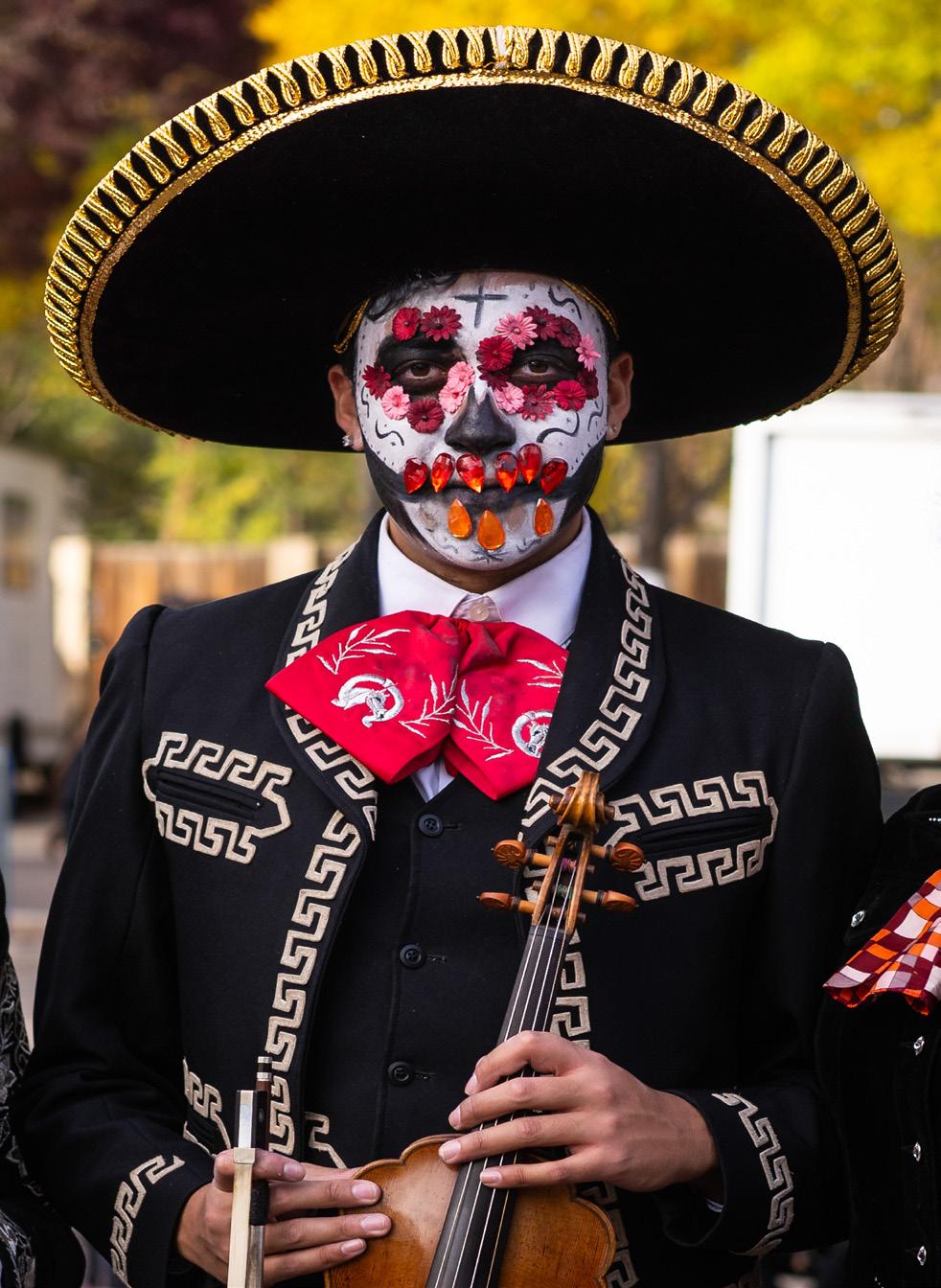

of Alamogordo, see page 27.
















of Alamogordo, see page 27.













NEW MEXICO’S wide-open spaces are ready to welcome you. For anyone seeking a change of scenery or in need of a more extensive getaway with a touch of adventure, there has never been a better time to look to the stunning four regions
of picturesque New Mexico. The state’s natural beauty, rich history, outdoor activities, and diversity of cultures offer experiences of a lifetime for staycationers and vacationers alike.
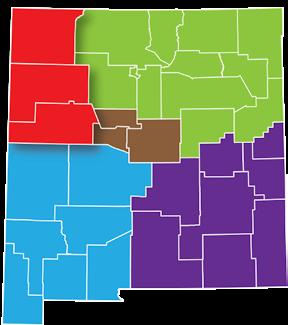
WHETHER you venture to the Four Corners monument (where you can stand in four states simultaneously), are drawn to the ancient mystery of Chaco Canyon, join in the annual Gallup Inter-Tribal Indian Ceremonial in August, or wish to cruise historic Route 66, there is much in this region of New Mexico to heighten the senses and stir dormant primal connections.
Amid 200-million-year-old cliffs outside Gallup is Red Rock State Park and Museum, featuring interpretive displays of ancient Anasazi culture alongside modern art from the Navajo, Hopi, and Zuni tribes. Consider with each step that you are walking on land once occupied by the ancient Anasazi Indians.

Immerse yourself in antiquity at El Morro National Monument, (south of Interstate 40, west of Ramah on NM 53) where fragments of history and ancient cultures are embedded in the great sandstone promontory. Over hundreds of years, Spanish and American travelers rested and carved their signatures, brief messages and the dates they were there. For operating hours and trail information, call the visitor center at 505-783-4226, ext. 801, for the most up-to-date information. Campground sites are available on a first-come, first-served basis.
Art gallery walks are among the most popular activities in Farmington. Start at Orchard Park where maps and other information can be found, and meander to your heart’s content among the artists in shops, in the park, and outside along the route. While walks are offered year-round virtually through the Farmington Convention Center at farmingtonnm. org/virtual-art-walk, the seasonal self-guided walks are not to be missed if you can make one or more of them in person. They are scheduled to occur from 5-8 p.m. April 5 and June 7 and from 5 to 9 p.m. October 4. See the Northwest New Mexico Arts Council website, nwnmac.org, for details. A downtown Makers Market also occurs Thursdays, June 6-September 25, from 3 p.m. to dusk. It features vendors of fresh produce, baked goods, handmade leather products, and art, as well as live entertainment and more.
Venture along historic Route 66 where you can see the motels, diners, and neon of the era as the "Mother Road" winds its way west out of Albuquerque toward Gallup. For railway buffs and anyone interested in the history of the Southwest, Gallup’s historic railway depot is worth a photo op. The Southwest Indian Foundation also operates the Gallup Cultural Center inside the depot, 201 E. Highway 66.
(continued on Page 6)



4: Five New Mexico Regions Offer Boundless Exploration
4: Northwestern New Mexico: Rocks, Roads and Bling
6: Northeastern New Mexico: A Raucous Past Among Varied Vistas
10: Southwestern New Mexico: Frontiers Old and New
12: Southeastern New Mexico: From Caves to Casinos and Sand Dunes to Space
14: North-Central New Mexico: History, Art, Culture
18: Scenic Byways Make Mapping a Road Trip Easy
24: Pop a Pistachio: New Mexico’s Other Tasty Treat
27: Vacation 2024: AlamogordoGateway to Your Next Adventure
38: The Albuquerque Hispano Chamber of Commerce
Climb aboard the historic Cumbres & Toltec Scenic Railroad which operates in the scenic landscapes of southern Colorado and northern New Mexico. Journey back in time experiencing the Old West as it was in 1880, as you venture over the highest mountain pass reached by rail, cross gorges and trestles, blast through tunnels, and chug across alpine meadows and high deserts. Depart from Antonito, Colorado or Chama, New Mexico for a ride of a lifetime!


(continued from Page 4)
It contains a storyteller museum and displays about trains, coal mining, weaving, the Navajo Code Talkers, Native American sand paintings and silversmithing, as well as the stories of Route 66.
A scenic drive off I-40 east of Grants escorts you to the otherworldly volcanic flows of El Malpais National Monument, located on exit 85 off I-40 in Grants. Trails and parking areas outside the Visitor Center are open 24 hours a day, seven days a week, except for the Sandstone Bluffs Overlook, which is open from sunrise to sunset. The Visitor Center is open 9 a.m. to 5 p.m. daily, closed major holidays. Stop in for maps, information, orientation, cave permits, a Western National Parks Association bookstore, museum exhibits, and park movies. For more information and updates on operations, visit https://www.nps.gov/elma/planyourvisit/ conditions.htm.
Take a stop from your scenic tour of the region at Sky City Casino Hotel on I-40, east of Grants. Sky City offers 24-hour gaming with more than 640 of the newest and hottest slot and video poker machines, Las Vegas-style table games, bingo, and live entertainment, with fine accommodations and dining all in one place.
Trading posts and shops throughout Northwestern New Mexico offer a variety of new and old Native American arts and crafts, including painting, pottery, jewelry and carved fetishes.


New Mexico's diverse terrain includes everything from the state’s highest mountain, to the valleys and clear water streams of the Pecos River. As a result, this quadrant of New Mexico has some of the most breathtaking scenery to be found.
As expansive as the mesa is the area’s history, which includes outlaws, Rough Riders, a raucous cow town and the dwellings of ancient civilizations. Experience the mystery and intrigue of the historic St. James Hotel in Cimarron, a tiny community with a storied past that includes Buffalo Soldiers and train robbers.
Make a stop along the legendary Santa Fe Trail into the once-bustling cattle town in Las Vegas, where Teddy Roosevelt came to recruit the Rough Riders. The City of Las
Vegas Museum and Rough Rider Memorial Collection tell the stories of Roosevelt’s charge on San Juan Hill in the Spanish-American War.
(continued on Page 9)



300+ years of history
500 acres of New Mexico landscape 34 historic buildings
7 exciting festival weekends Open June–October

Wednesday–Sunday | 10 am–4 pm Hours
Become
(continued from Page 6)
Venture to nearby Fort Union and walk through the territorial style adobe remnants of the region’s largest 19thcentury military fort. Recognized for its antique shopping opportunities, Las Vegas also provides a chance to learn the New Mexico Harvey House story. Entrepreneur Fred Harvey built a series of iconic hotels and restaurants along the railway routes of the Southwest, attracting tourists to the area from around the world at the turn of the 20th century.
Nestled among the majestic Sangre de Cristo Mountains just six miles from the Colorado border, hospitable Raton offers fresh air, expansive scenery, a variety of recreational activities, a vibrant art scene and regular downtown events.
A dozen miles northeast of Raton, you’ll find camping, fishing and hiking in Sugarite Canyon.
About 40 miles west of town, enjoy abundant wildlife, luxurious spa amenities and fine dining amid the ultimate outdoor adventure on Ted Turner’s 585,000-acre Vermejo Park Ranch.
Finally, don’t miss the National Rifle Association’s largest shooting range in the country. The NRA Whittington Center, located southwest of Raton, offers guided hunts, shooting, camping, firearms training and pistol courses. Call ahead at 800-494-4853 to create your experience.
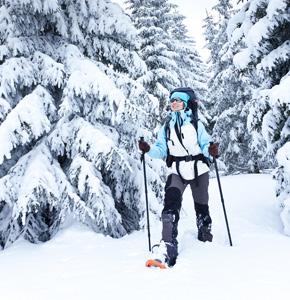
Developed from Germany’s world-famous audiological devices of Siemens the IX platform from Signia brings you the best possible solution for your hearing situation.
I have hearing aids to understand what my wife says, and to be able to hear and talk with my grandchildren. As humans we lose the ability to hear high pitch sounds. That is why I can hear my buddy’s deep voices ne but need hearing aids to hear and understand my wife. Especially in background noise. Signia is the hearing aid that I use. I sell 5 top of the line brands but the Signia is the best solution for my hearing situation! Signia’s IX is the new gold standard for anyone who cares about speech clarity in conversation, especially in a noisy environment. "Virtually invisible, the new IX hearing aids sit comfortably either inside or behind your ear In fact, many users say that people can't tell they're wearing a hearing aid. Why are they so good?





SMACK DAB in the middle of Southwestern New Mexico on 18,000 acres of desert is the commercially licensed Spaceport America. Built as a hub for future space travel, the facility is situated along a path followed centuries ago by other like-minded souls seeking a new frontier. Visiting and touring Spaceport America requires prior authorization and a minimum 24-hour advance reservation. To inquire about private tour availability, call Final Frontier Tours at (575) 267-8888 or email cr@finalfrontiertour.com. The secure, futuristic facility stands in stark contrast to the many historical landmarks dating back hundreds of years throughout this quadrant of New Mexico.
Nearby, the tiny agricultural community of Hatch proudly produces New Mexico’s famous green chile. Name recognition of New Mexico’s beloved signature crop from Hatch is growing nationwide. The region is also home to many pecan orchards and vineyards.
Just outside of Las Cruces, stop in for a glass of award-winning wine or pick up a fine vintage to take home at Rio Grande Winery, 5321 N Highway 28. The winery produces nearly 20 wine varietals, including Mission wine (a variety that dates back about 500 years), pinot grigio, sauvignon blanc and malbec on its 23 acres. The sweet oasis in the desert has for decades provided panoramic views of the Mesilla Valley. Live music often is scheduled Thursdays through Sundays. The winery is closed Mondays, and operating hours vary on other days. Visit https://www.riograndewinery.com or call (575) 201-3744 for more information.
Once a railroad hub, Las Cruces is home to New Mexico State University and serves as a center for agriculture, science, and technology research. A short jaunt to the southwest part of Las Cruces and you’ll find yourself in the quaint village of Old Mesilla with its distinctive central plaza and shopping venues.
Head west toward New Mexico’s bootheel and enjoy the rustic ambiance of Deming, Lordsburg, and bordertown Columbus. Check local listings in these areas for reenactments of life on the frontier.
Civil war history, mining, prospectors, and the Wild West are all part of the texture of Silver City, located just three miles east of the Continental Divide. No trip to this area is complete without a visit to Catwalk National Recreation Area, five miles off the highway from the village of Glenwood. Suspended dramatically along a beautiful canyon and over a cool creek that borders the Gila Wilderness, the catwalk is a half-mile-long bridge that is universally accessible for all visitors.
In the Mimbres Valley, volcanic ash shaped by wind 35 million years ago created the geologic formations that comprise City of Rocks State Park, halfway between Silver City and Deming.
Fort Bayard offers a glimpse at Civil War Life. The spectacular Gila Cliff Dwellings, Gila National Monument, and Gila Wilderness are an indescribable must-see. Travelers will enhance their experience by making time to drive the Trail of Mountain Spirits, a 93-mile National Scenic Byway that winds around the southwest corner of New Mexico and past ancient cliff dwellings.
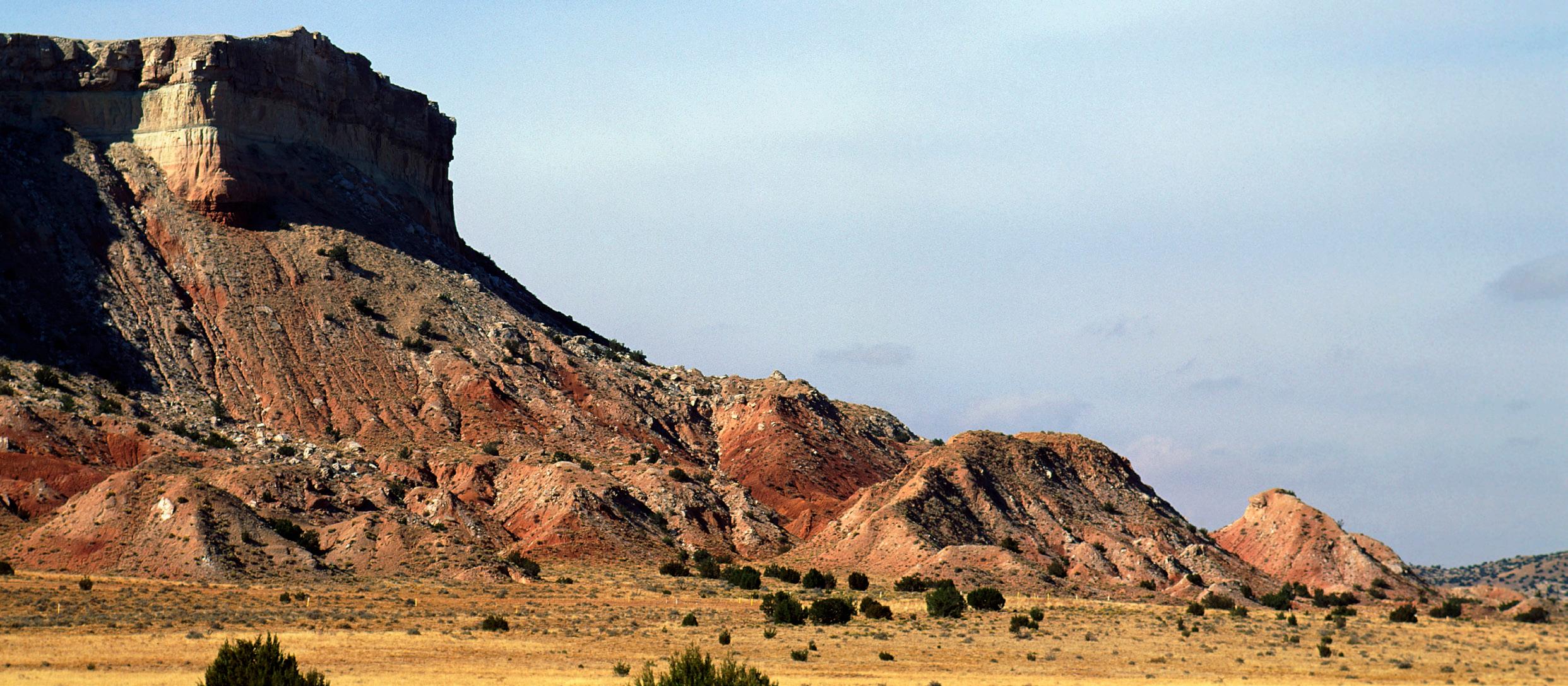

Giuseppe Verdi
June 28
July 3, 6, 12, 19
August 1, 5, 10, 17, 20, 24

For those interested in taking outdoor adventures at national parks, exploring the possibility of UFOs, learning about the Space Age, or even about atomic warfare, a sojourn to Southeastern New Mexico promises all of that and much more.
Since release of the Academy-award winning movie Oppenheimer, interest the Atomic Age has increased. Anyone wanting to step back to that period of our history should start in Alamogordo, famous for its connection with the first atomic bomb test explosion, conducted at the Trinity Site in 1945. Guided tours of the site are now being offered through the International Space Hall of Fame Foundation in support of the New Mexico Space Museum, also in Alamogordo. For details on Trinity Site tours, visit https://www.spacehalloffame.org/trinity-sitetour-reservation/. Be sure to also make time for the Space Museum, which has exhibits on rockets, what it’s like to live and work in space, and the significant role that space science in New Mexico has played in America’s Space Program. Visit https://www.nmspacemuseum.org/ for information.
Alamogordo’s pioneering history is celebrated at the Toy Train Depot, a museum dedicated to restoration, acquisition, display and interpretation of railroads of all scales and gauges, including full-scale train items. There’s a little something for everyone - young, old, history buffs, train enthusiasts, Southwest adventurers, and souvenir seekers. Visit https://toytraindepot.org/ or call (575) 437-2855 for the most recent information.
Before heading out of the area, take a nutty photo at the World's Largest Pistachio, 7320 US HWY 54 70. The 30-foot structure, built in 2007, stands outside PistachioLand, where nuts and pistachio bobbleheads can be purchased.

Less than a half hour from Alamogordo, walk through dunes of glistening gypsum sand and experience the unforgettable beauty of White Sands National Park. This is where the first settlers came more than 10,000 years ago and the U.S. military conducted research during World War II. The Visitor Center and gift shop are open daily at 9 a.m. The park, including the Dunes Area, hiking trails, and picnic areas are open 7 a.m. to sunset throughout the year. Visit https:// www.nps.gov/whsa/planyourvisit/hours.htm for details.
The White Sands Missile Range Museum provides history of the region. Due to missile testing on the adjacent White Sands Missile Range, it is occasionally necessary for visitor safety to close the road into the park for several hours. U.S. Highway 70 between Alamogordo and Las Cruces is also closed during times of missile testing. Visitors on a tight schedule are encouraged to check the park closure web page, https://www.nps.gov/whsa/planyourvisit/parkclosures.htm, on the day before arrival to confirm hours of operation. You may also call (575) 678-2250 or visit https:// wsmrmuseum.com/ for updates.
A short jaunt away is Artesia, where you can experience art and culture on the street downtown. A series of bronze statues are positioned within the downtown district on Artesia’s History in Bronze and Downtown Walking Tour. It begins at the Artesia Chamber of Commerce and Visitors Center in the historic train depot and stops at the impressive Artesia Public Library, home to a 46-foot Peter Hurd mural. The artwork was rescued from a downtown Houston building slated for demolition. Call (575) 746-2744 for more details.
The diverse and dramatic geology in this region features flat expanses of seemingly endless prairie connecting to the foothills of the Sacramento Mountains, in which the villages of Cloudcroft and Ruidoso nestle. There are gambling venues to be explored in and around Ruidoso, including the many amenities and luxury of the Inn of The Mountain Gods, and Billy the Kid Casino and Ruidoso Downs Race Track.
To the south is Carlsbad, where Carlsbad Caverns National Park invites visitors to trek beneath the earth’s surface to see dozens of limestone caves. Bats that sleep in them by day fill the evening sky as they head out in a cloud of black to hunt insects. Reservations must be purchased online or by calling (877) 444-6777. Be aware that reservations only secure an entry time; entrance tickets must still be purchased upon arrival at the visitor center. For more information, visit https://www.nps.gov/cave/planyourvisit/index.htm.
In Lincoln County, see the courthouse where notorious outlaw Billy the Kid shot his way out of jail. New Mexico’s most visited historic site, Lincoln offers an immersive experience
(continued on Page 14)

(continued from Page 12)
hearkening back to a violent period in the state’s history, the Lincoln County Wars.
A short drive away from Lincoln is Fort Stanton, established to protect settlements along the Rio Bonito in the Apache Wars. Built in 1855 as a U.S. military fort, this is the largest of New Mexico’s state historic sites. Kit Carson, Billy the Kid and Buffalo Soldiers of the 9th Cavalry all lived at Fort Stanton. Confederate forces occupied the outpost in the beginning of the American Civil War, and later it served as America's first federal tuberculosis sanatorium.
If possible, be sure to visit the UFO Museum in Roswell, open 9 a.m.- 5 p.m. daily, except major holidays, with an admission fee of $4 to $7 depending on age and military status.
Nearby, take a spin to Bottomless Lakes State Park. It lies 14 miles southeast of Roswell, where sinkholes range to 90 feet deep. The park’s recreation area is open 6 a.m. to 9 p.m. daily. Check the website for closures and construction updates: https://www.emnrd.nm.gov/spd/find-a-park/ bottomless-lakes-state-park/.

in the state, the oldest state capital in the country, world-class art communities, an authentic railroad town, and excellent accommodations can all be found in New Mexico’s NorthCentral quadrant cities of Albuquerque, Santa Fe, Taos, and neighboring towns.
Majestic mountains rise abruptly from great expanses of plains, falling off to wooded river valleys. This diverse terrain provides a wealth of outdoor activities, including hiking, skiing, cycling and mountain biking. Just as varied are the surrounding communities, which comprise a mix of small-town charm, bucolic serenity, and a sleepy mountain-ringed village.
Make some time to experience the rich history and culture of Belen, founded in 1740 and interwoven with Spanish, German, and other cultures. The
community boasts an original Harvey House and offers a glimpse at what this historic railroad town looked like in the early 1900s. There are also plenty of shopping opportunities.
Birders, golfers, art lovers, historians and campers will find plenty of entertainment in Socorro. Check out the city’s website for a full list of activities available in the area, including walking tours, dirt biking, and shopping and dining.
If you like games of chance, then try your luck at Route 66 Casino on Interstate 25, west of Albuquerque. The casino floor features more than 1,300 slots, from pennies to high stakes machines, Vegas-style table games, a popular bingo hall, as well as full hotel accommodations, food, and regular entertainment options.
The rich history of Los Lunas can be discovered with a stop at its Visitors Center, open 8 a.m. to 5 p.m. Monday through Friday. While you’re there, look at the rich history of Los Lunas through a photo display inside the building.
Don’t miss Albuquerque’s Historic Old Town Plaza, the humble roots from which Albuquerque grew. Old Town
(continued on next page)

(continued from previous page)
offers an impressive selection of New Mexico cuisine and the work of local artisans in an area that surrounds historic San Felipe de Neri Church. The City’s BioPark and several museums, including the Albuquerque Museum and the New Mexico Museum of Natural History, are nearby. The plaza also offers a therapeutic ambiance if you just want to sit and watch the world go by.
Sixty miles north of Albuquerque on I-25, historic Santa Fe has world-class art galleries, museums, and restaurants, and is the seat of state government. Explore the fascinating history of the Palace of the Governors on historic Santa Fe Plaza amid the city’s signature Pueblo Revival architecture. Savor local cuisine at any number of restaurants, or grab a bite from a food cart's tasty hand-held faire on the plaza.
Step back in time just south of town at El Rancho de las Golondrinas. The Southwest’s premier living history museum, whose name means The Ranch of the Swallows, is dedicated to the history, heritage, and culture of 18th- and 19th-century New Mexico. Located at 334 Los Pinos Road, this historic site was an important paraje, or stopping place,
(continued on Page 16)









(continued from Page 15)
along the famous Camino Real, the Royal Road from Mexico City to Santa Fe. Self-guided tours are available 10 a.m. to 4 p.m. Wednesday through Sunday, June 5 through the end of October, with guided tours available by reservation in April and May. At least two hours is recommended for a visit. The museum is closed November through March. Call 505.471.2261, ext. 101, for more information, or visit https://golondrinas.org/.
North of Santa Fe in the town of Española, take a spin by the Santa Claran Hotel and Casino; the Puye Cliff Dwellings, which give visitors an immersive experience into the lives of the ancients; and the Black Mesa Golf Course, a great challenge to duffers.
Known as a world-class ski area for decades, Taos Ski Valley has gained renewed attention since a $300 million redevelopment gave it a facelift that includes a hotel, a spacious children’s center and other added amenities that can be enjoyed year-round. Skiers and non-skiers alike benefit from Taos' clean air and magnificent views, rich spiritual traditions, creative inspiration, abundant outdoor recreation and shopping. A day in Taos will change your outlook and perhaps even your style.
For additional winter sports options, check out Angel Fire Resort, which offers a memorable Rocky Mountain experience for families and outdoor enthusiasts. Located 8,600 feet above sea level, the resort has views of Wheeler Peak, the highest point in New Mexico.
Eight miles south of the Colorado border, the small town of Chama boasts elk habitats, clean rivers, hunting, fishing, rafting, hiking and camping, as well as a must-see night view of the Milky Way. Serious hikers can pick up the Continental Divide Trail not far from town. Chama’s train depot is the western terminus of the Cumbres & Toltec Scenic Railroad. The train is scheduled to operate a regular season May 25-October 19. Visit https://cumbrestoltec.com/ for tickets and updates. It’s a good idea to book in advance.
Chama also hosts an annual Fourth of July fireworks display, and in the fall, the area around Chama is one of the best places in the state to see brilliant foliage.
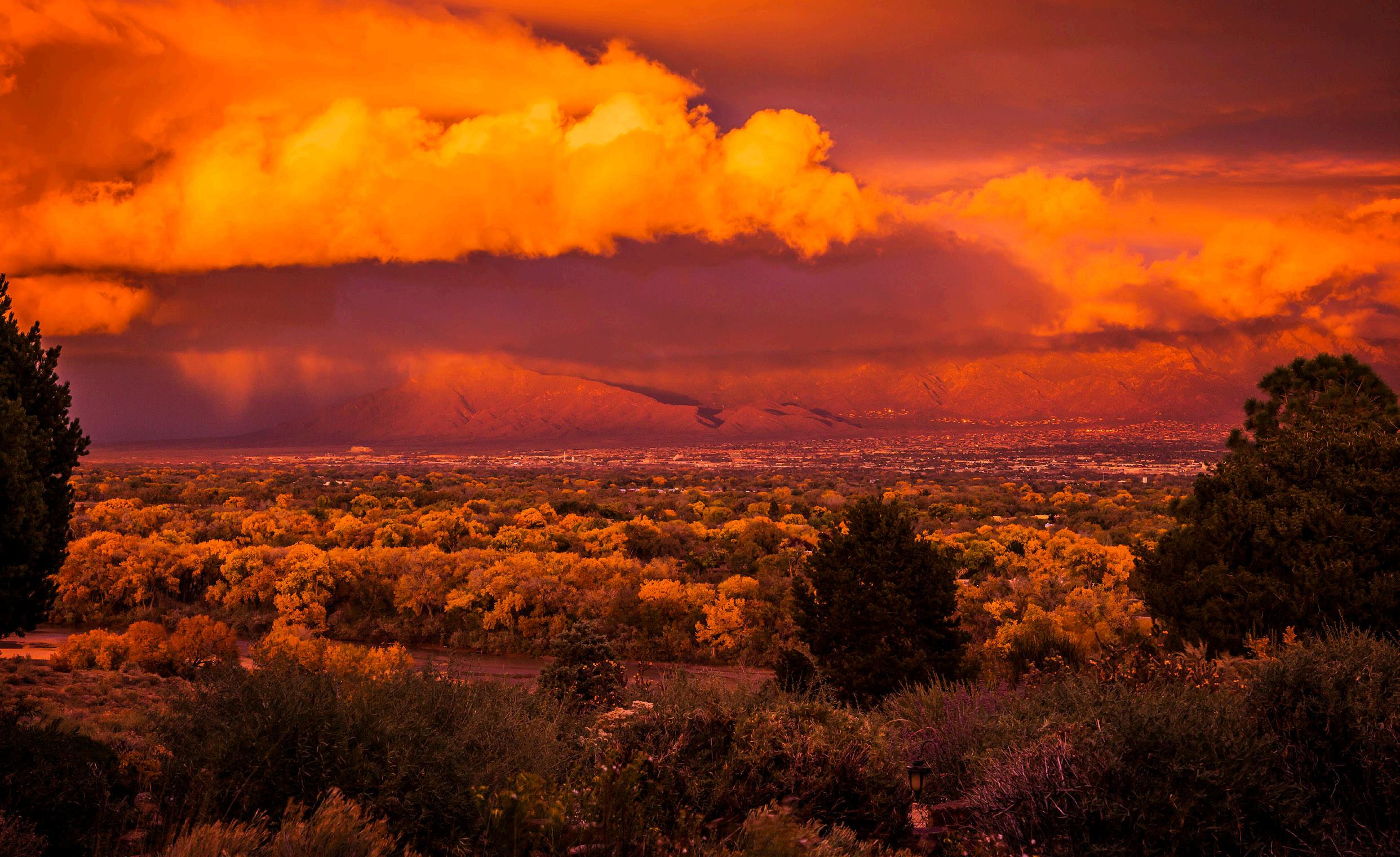 Storm over the Sandia Mountains. Photo by John Yost.
Storm over the Sandia Mountains. Photo by John Yost.


Rediscover yourself in Raton, New Mexico! Breathe in fresh mountain air. Capture your first volcano selfie. Teach the kiddos to fish for trout. Enjoy your morning coffee alongside towering vistas and mesas. Immerse yourself in the culture of the Wild West. Eat all the green chile. Explore Raton!
Your options are limitless and lucky for you, outdoor activity is literally at our doorstep! Hang out in Sugarite Canyon State Park or drive to our regional attractions. There’s over 1 million acres of fun in every direction for exploring, hunting, camping, hiking, fishing, and more!
See performances and view local art in the Historic Arts & Cultural District! Located in downtown Raton, marvel at the preservation of the Shuler Theater or browse through galleries showcasing local talent. We’re keeping the arts alive in Raton!
Summer is the season to spend in Raton! Almost every weekend date is booked for live music, pin up contests, motorcycle rallies, comedy shows, shopping, hot air balloon rides, and enjoying our company. Plan your trip around our signature events!
STEP BACK IN TIME
From the dinosaurs to the western era or from the beginnings of rock ‘n’ roll to modern times, Raton and Colfax County’s historical charm is unmatched. Learning is at every corner, and unique knowledge is waiting to be discovered in Raton!

The following has been compiled from information provided by the websites of the U.S. Department of Transportation, the New Mexico Tourism Department, the New Mexico Department of Transportation, America’s Scenic Byways, the National Scenic Byway Foundation, and the New Mexico Bureau of Geology and Mineral Resources.
NEW MEXICO offers 25 recognized scenic byways, totaling 2,900 miles that will have you yelling, “Road trip!” Committing to any of them promises an eclectic photo album and “remember when” stories to last generations. The byway you select determines the theme and vibe of the trip: Old West outlaws or geologic splendor. Cool mountain trails or contemporary art galleries. Ancient ruins or abandoned mining towns.
No matter your selection, the byways showcase some of the most outstanding scenic beauty, historically significant locales, cultural richness and bizarre features of the state. Eight of the byways have even earned National Scenic Byway distinction from the U.S. Department of Transportation. There are more than 1,200 national byways across the country, all of which exhibit one or more of six core intrinsic qualities — scenic, historic, recreational, cultural, archaeological, or natural.
We have chosen to highlight the following six byways – three national and three state. Taken together, they crisscross a major portion of New Mexico and offer a variety of time commitments.
Distance: 132-mile loop
Drive time: Three hours to a full day
The Jemez Mountain Trail takes visitors through some of the best and most varied assets that Northern New Mexico has to offer – from incredible geological formations, ancient Indian ruins, and abundant hiking and fishing, to the birthplace of the atomic bomb. Sites include Jemez State Monument, Bandelier National Monument, Soda Dam, the Valles Caldera and the Jemez Mountain Hot Springs.
The byway officially begins at the junction of U.S. 550 and N.M. 4, northwest of Bernalillo in the pastoral village of San Ysidro, named for the patron saint of farmers. Starting here will take you immediately through the Jemez Reservation and the Jemez Pueblo where the Walatowa Visitors Center has information on the Native people and their culture. About 3,400 tribal members still reside here. Visitors can enjoy their traditional foods and pottery in the village and at

roadside stands in the stunning Red Rocks area. The Pueblo offers a 1.5-mile guided tour of Red Rock Canyon Trail on most days, which is an ideal way to take in the scenery and learn more about the culture, past and present. Incredibly, the Pueblo has preserved its ancient Towa language, the only culture to speak it.
From here, the road continues northeast to Jemez Springs, where you can relax in the Jemez Springs Bath House on the village plaza. Dating to the 1870s, the bath house surrounds bubbling natural springs. Next, stop at the Jemez Historic Site and State Monument, which protects the ruins of Giusewa. The village was built about six centuries ago by the ancestors of the Jemez people.
Further on, pass the incredible geological formations of Soda Dam and Battleship Rock, as well as cone-shaped “tent” rocks, or hoodoos. Soda Dam is a 7,000-year-old calcium carbonate formation that creates a truly magnificent natural bridge over a stream and waterfall on the east side of Rt. 4. After wading, have a picnic while taking in Battleship Rock, a 200-foot-tall natural land form of volcanic rock named for its resemblance of a Navy warship. The East Fork Jemez and San Antonio rivers join at a scenic streamside picnic area where you can also hike and fish. The Jemez Falls campground is nearby with a 1/4-mile easy hiking trail that leads down to a waterfall.
(continued on next page)
(continued from previous page)
By continuing east, you can take some short sides trips that are well worth the effort. About five miles northwest of the intersection of NM 4 and NM 485, you can travel through the Gilman Tunnels, which mark the transition between the Jemez Mountains and the Sierra Nacimient. Two narrow and unusually high tunnels were cut through granite in the 1920s to facilitate passage of logging trains through this rugged and constricted section of Guadalupe Canyon, known as the Guadalupe Box.
Three miles to the east on NM 290 takes you to Ponderosa, a family-owned winery known for Rieslings and pinot noir. Tours and tastings are available.
Head further northeast and see the Valles Caldera, a magnificent crater that formed about 1.2 million years ago when a massive volcano erupted in the Jemez Mountains. The 14-mile-wide circular depression it left behind is called a caldera and serves as a lush home to a regularly seen elk herd. Visitors can experience the beauty of this unique geologic landscape at the Valles Caldera National Preserve. You can hike a trail around a lava dome, catch
trout in streams, or stop at the Ranger Station for souvenirs, programs, and additional park information. All 89,000 acres are managed by the National Park Service.
The road continues east to Bandelier National Monument, housing several thousand ancestral Pueblo dwellings within almost 33,000 acres of steep-walled canyons. Stretch your legs at Bandelier’s visitor center and trails for an hour or two. Bandelier, named after the 19th-century anthropologist Adolph Bandelier, who helped research and preserve the ancient Pueblo heritage of New Mexico, offers a glimpse at some well-preserved ruins of 13th-century Pueblo cliff dwellings nestled amid steep volcanic tuff walls. The flat Main Loop Trail is just over a mile long and includes opportunities to climb short ladders into the ancestral dwellings and to see a variety of petroglyphs. For those with more time, the monument’s backcountry trails lead in and out of canyons and cross large flat mesas, showcasing a spectrum of volcanic geology.
Loop around up to the once top-secret scientific community of Los Alamos, recently featured as the site of the
(continued on Page 22)

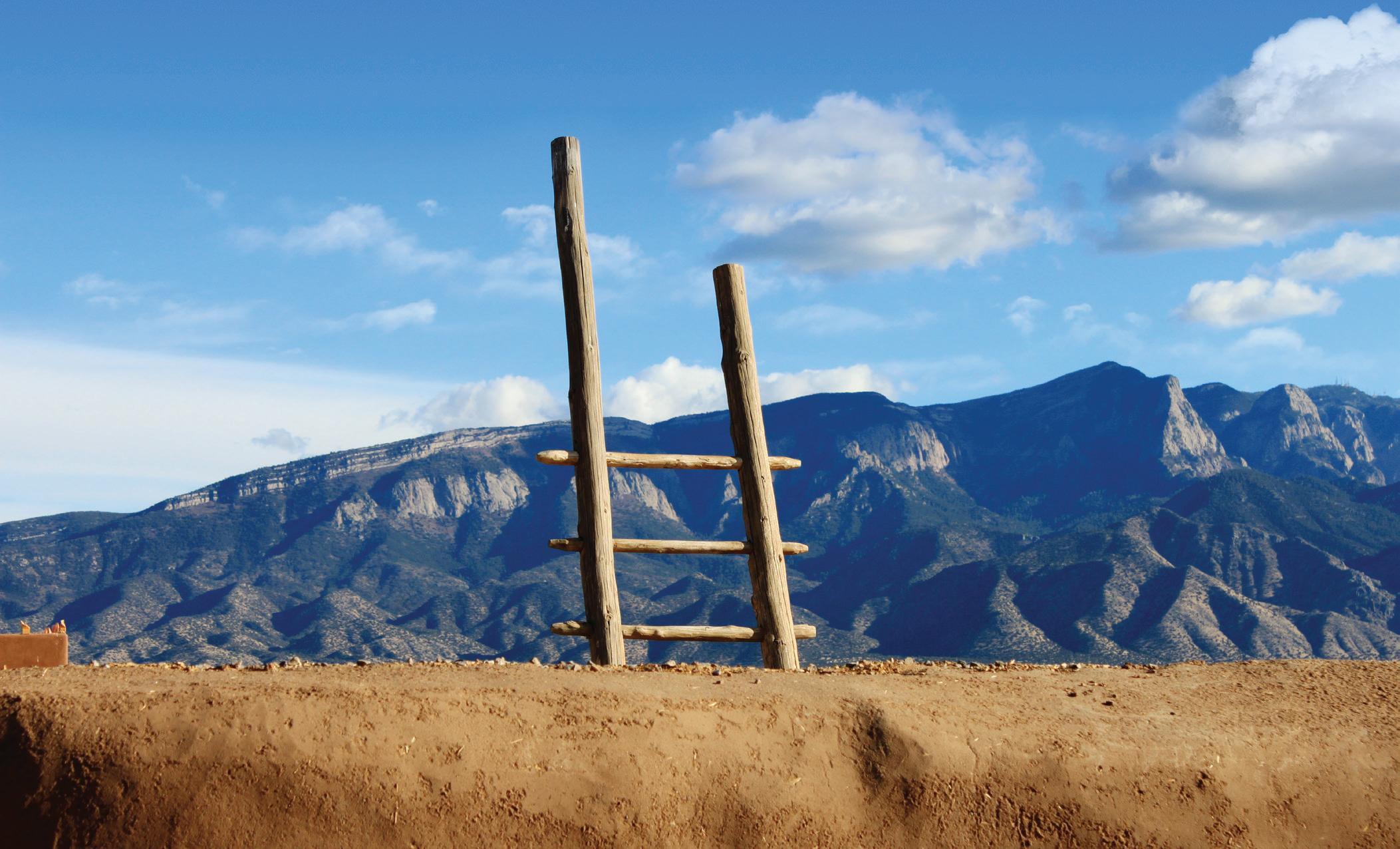
new mexico museum of space history
Alamogordo • 575-437-2840 nmspacemuseum.org
new mexico museum of natural history & science
Albuquerque • 505-841-2800 nmnaturalhistory.org
national hispanic cultural center
Albuquerque • 505-246-2261 nhccnm.org


new mexico farm & ranch heritage museum
Las Cruces • 575-522-4100 nmfarmandranchmuseum.org
museum of indian arts and culture
Santa Fe • 505-476-1269 indianartsandculture.org
museum of international folk art
Santa Fe • 505-476-1200 internationalfolkart.org

new mexico history museum
Santa Fe • 505-476-5200 nmhistorymuseum.org
new mexico museum of art
Santa Fe • 505-476-5063 nmartmuseum.org
new mexico historic sites
Statewide • 505-476-1130 nmhistoricsites.org

 clockwise from top left: Ladder leading into Coronado Historic Site’s painted kiva, photograph by Eric Moldonado. Jar, Acoma Pueblo or Laguna Pueblo, ca. 1910, gift of Juan Olivas, MIAC 12024/12, photograph by Addison Doty. Eagle Dancers performing at Indian Market, Santa Fe, New Mexico, 1991, courtesy Palace of the Governors Photo Archives (NMHM/DCA), neg. no. HP.2014.14.676. Fort Selden during the Summer Nights event, photograph by Norm Dettlaff/Visit Las Cruces. Image courtesy of Baila! Baila! Dance Academy and Lozoya Studios. Jaguar mask, ca. 1960, Mexico, gift of the Girard Foundation Collection (A.1979.17.768), Museum of International Folk Art. An astronaut on the John P. Stapp Air and Space Park, courtesy of New Mexico Museum of Space History.
clockwise from top left: Ladder leading into Coronado Historic Site’s painted kiva, photograph by Eric Moldonado. Jar, Acoma Pueblo or Laguna Pueblo, ca. 1910, gift of Juan Olivas, MIAC 12024/12, photograph by Addison Doty. Eagle Dancers performing at Indian Market, Santa Fe, New Mexico, 1991, courtesy Palace of the Governors Photo Archives (NMHM/DCA), neg. no. HP.2014.14.676. Fort Selden during the Summer Nights event, photograph by Norm Dettlaff/Visit Las Cruces. Image courtesy of Baila! Baila! Dance Academy and Lozoya Studios. Jaguar mask, ca. 1960, Mexico, gift of the Girard Foundation Collection (A.1979.17.768), Museum of International Folk Art. An astronaut on the John P. Stapp Air and Space Park, courtesy of New Mexico Museum of Space History.





(continued from Page 19)
Manhattan Project in the award-winning blockbuster movie Oppenheimer. While Los Alamos National Laboratory is closed to visitors, the nearby Bradbury Science Museum tells about the history-shaping project, which created the first atomic weapons.
Heading back west to the main loop, visit Fenton Lake, a year-round retreat, surrounded by ponderosa pine forests. Some of the trout that stock the lake are from Seven Springs Hatchery, about four miles to the north. Built in 1936, the hatchery is responsible for production and distribution of native Rio Grande cutthroat trout, New Mexico’s State Fish. This journey can also be started in Los Alamos, finishing up in Santa Fe by taking State Road 501 and turning right onto State Road 4 (SR 4) toward Jemez Springs.
Distance: 84 miles
Drive time: 2-4 hours
This byway starts and ends in Taos on NM 522 as it circles around Wheeler Peak, the highest in New Mexico at 13,161 feet. Look for special Enchanted Circle markers to help guide your way. The route links the oldest continuously occupied
(continued on Page 30)




Schweers wanted to return to their agriculture roots after a career in the Air Force that culminated at Holloman Air Force Base near Alamogordo. When 400 seedling pistachio trees, the first planted in New Mexico, came up for sale, the couple thought a perfect opportunity had presented itself. Neighbors thought the Schweers were, well, nuts.
The Schweers had done their homework and found that the Tularosa Basin in South Central New Mexico had a climate very similar to the pistachio-growing regions of Iran and Turkey. It was a natural desert crop to add to the agricultural scene. Ancient legends from the Middle East allude to the mystique of the tasty nut being associated with romance and royalty. So, besides being tasty and heart healthy, it is fun! One of the legends is that young lovers can walk through the groves holding hands, and if they listen carefully and hear the nut shells popping open, theirs is indeed true love. Supposedly, the Queen of Persia (Iran) believed pistachios were an aphrodisiac and kept them as treasure in her storehouses.
Celebrating 50 years in business, Eagle Ranch contains New Mexico’s oldest and largest-producing groves, with more than
13,000 trees. Totally self-contained, it is a fully integrated agribusiness, growing, processing, packaging and marketing its products to both wholesale and retail customers. All the farm products are sold under its familiar trade name, “Heart of the Desert”.
The Schweers’ son, Gordon, developed the original chile-flavored pistachios. The farm now boasts nine flavors. The family began a vineyard in 2002 and now has 24,000 grapevines in seven varietals. Chardonnay, cabernet, zinfandel, shiraz, riesling, malvasia bianca, and gewurztraminer make a wide range of wines possible.
Popcorn and pistachios continue to be a popular snack mix. Three distinct flavors—Pistachio Caramel; Green Chile Pistachio Caramel; and Red Chile Pistachio Caramel satisfy that famous New Mexico question….."Red or Green?" Both, of course! All are produced in the popcorn factory on the farm.
There are three store locations to serve you—the primary store on the farm beside Hwy 54/70, north of Alamogordo; Heart of the Desert at the Mercado in Mesilla; and Heart of the Desert at the Farm & Ranch Heritage Museum in Las Cruces. Orders ship worldwide, accessing the store via mail, phone, email, FAX, and online at www.heartofthedesert.com.
Tours of the farm are fun and free, and sampling the wine and gourmet products is delightful at all the locations!
*Story courtesy of Heart of the Desert.


ANY REASON, ANY SEASON —IT’S ALWAYS COOL TO BE IN CLOUDCROFT!
In Cloudcroft, every day offers a chance to embrace the timeless magic of Christmas, fostering connections, spreading kindness, and keeping hearts aglow with the warmth of the holiday spirit.



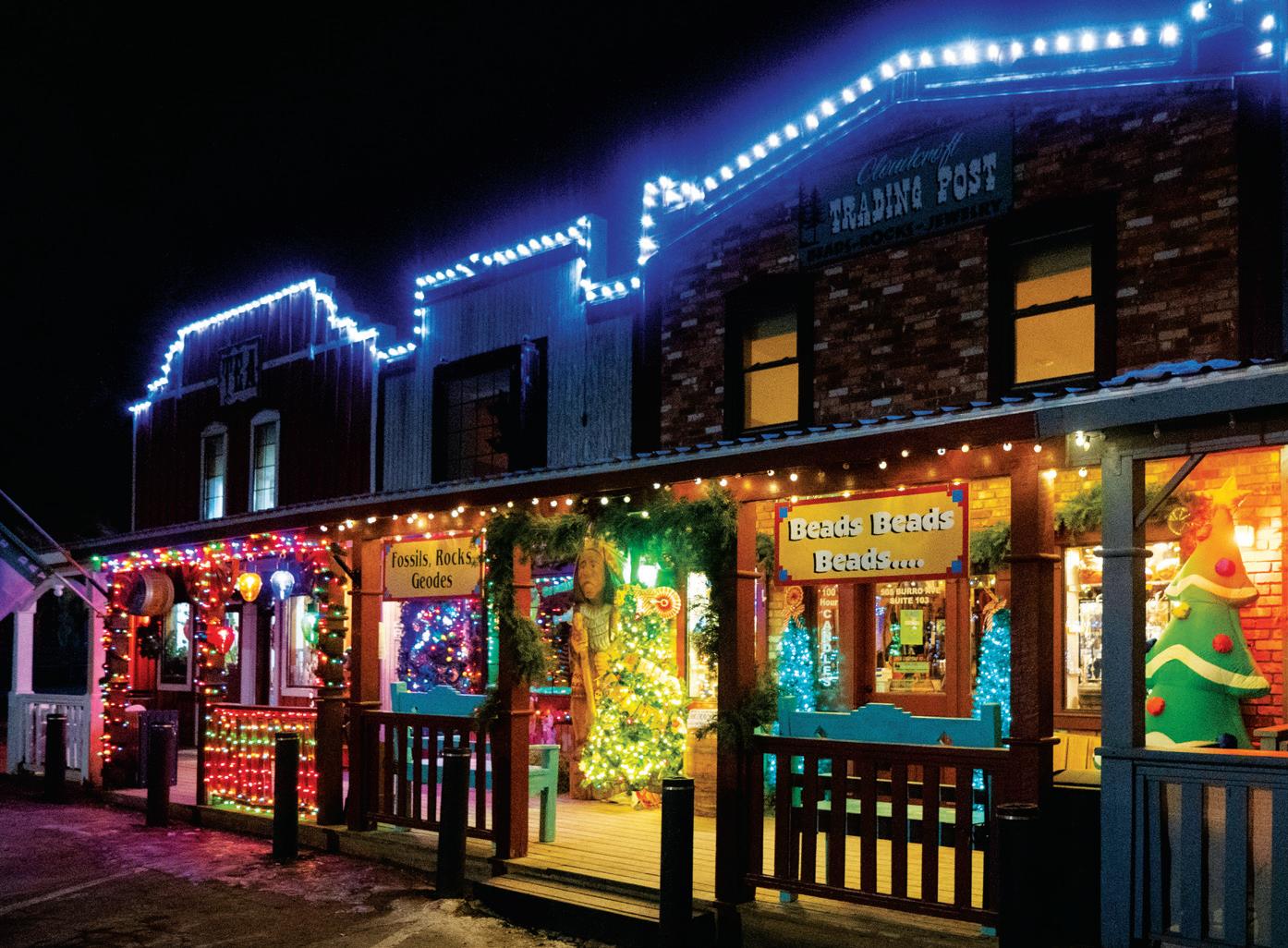
WHEN you are on the lookout for a new territory to explore, set your sights on Alamogordo, the small enclave in the southern central region of New Mexico that deserves a second look. Whether it be sledding dunes at White Sands National Park or chasing waterfalls in the Lincoln National Forest, this unique little city at the foothills of the Sacramento Mountains places you right on the doorstep of nature’s playground.

Did you know that White Sands National Park can be seen from outer space? The good thing though, is that when you’re in Alamogordo you’re only 14 miles away from this iconic National Park. Love photography? From Alamogordo, a city nestled at the foothills of the Sacramento mountains, it’s easy to capture your trophy shots of this gypsum wonderland. Head northeast on Highway 82, from Alamogordo, and you can be in the Lincoln National Forest, at 9,000 feet elevation in 20 minutes. Abundant wildlife resides among the majestic aspens and the numerous trails. Birds-eye views of the breathtaking Tularosa Basin will captivate you and your camera.
While in the city of Alamogordo, come learn and play at the oldest zoo in the Southwest, the Alameda Park Zoo, where over 200 animals await your arrival. Catch a glimpse of the newest colorful residents, the Mandrill monkeys. Learn all about how these brilliant primates communicate through their colorful fur! The historical zoo features over 12 acres of shady, grassy areas, a duck pond, a walk-through aviary, playground space, and picnic tables.
Feeling sporty? How about a round of golf at the Desert Lakes Golf Course? Friendly, fun, and challenging year-round golf at Alamogordo’s fairways awaits. Tournaments, range practice, and challenging play- all a great value for the price. Stunning views at no extra charge!
Ready to learn more about the birthplace of space history and exploration? The New Mexico Museum of Space History, an affiliate of the Smithsonian Museum, is right here in Alamogordo, offering spectacular views from high in the northeast part of the city. Dress up as an astronaut on the moon and pilot a space shuttle. Afterward, view an unforgettable show at the New Horizons giant screen dome theater and planetarium adjacent to the museum.

Alamogordo boasts a region ripe for growing fruits and nuts. Pistachios, pecans, and grapes all flourish here; orchards of lavender, apricot, peach, apple, cherry, and even pomegranate thrive in the high desert. Tours at the nearby pistachio farms and vineyards, and pick-your-own fruit during harvest season in La Luz, Tularosa, and High Rolls are fun hands-on activities. Foraging walking tours with live outdoor cooking demonstrations in downtown Alamogordo are more ways to have first-class agricultural enjoyment. Be sure to indulge in some local pistachio ice cream or awardwinning wine!
Alamogordo’s Mainstreet area highlights more treasures of the town. The Tularosa Basin Museum of History, Otero Arts, the Flickinger Center, the Toy Train Depot, and the delightful Murals are all enlightening, budget-friendly stops.
It may be hard to decide where to dine out in Alamogordo, and the local eateries are packed for good reason. Whether you crave a sit-down full-service meal or an al fresco bite from a food truck along with a craft brew, Alamogordo has you covered for hearty, satisfying local eating and drinkinglive music often included.
Even one of Alamogordo’s local grocery markets complete with a working tortilleria, coffee shop, grill, deli, and bar featuring 20 plus brews on tap, live music, and plenty of friendly faces, will have you yearning for more and visiting this gem of a city time and time again.
Visit AlamogordoNMTrue.com, or call 1.800.826.0294.













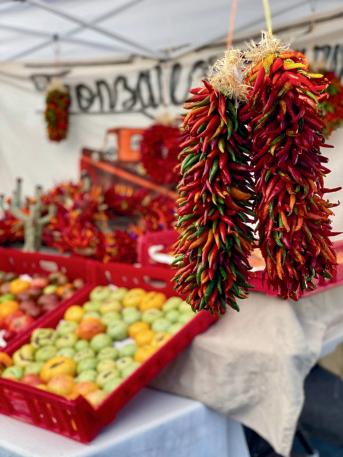




Roswell, New Mexico has something for everyone, from everywhere. The art lovers in the family will discover an eclectic art scene, including fine art and contemporary museums and galleries. Everyone will enjoy the natural wonders of Bitter Lake National Wildlife Refuge and Bottomless Lakes State Park. And you can stay in Roswell and see more of southeast New Mexico, with short daytrips to White Sands and Carlsbad Caverns. Plus, you’ll find otherworldly shopping, dining, family-friendly activities and golf right here in town. Plan your next adventure at SeeRoswell.com.
(continued from Page 22)
residence in New Mexico, Taos Pueblo, with Angel Fire, best known as a ski resort.
The Taos Valley has been home to the Tiwa-speaking Pueblo Indians for about 1,000 years. The Taos Pueblo’s multistory adobe skyline, reached by ladders, sits on the banks of the Rio Pueblo and has been the subject of painters and photographers for more than a century.
Indeed, Taos has been an artist haven ever since the Taos Society of Artists was formed in 1914. Later, art patron Mabel Dodge Lujan brought in noted artists and authors like D.H. Lawrence, Georgia O'Keeffe, Nicolai Fechin, and Ansel Adams. The town is a treasure trove of old homes, museums, interesting shops, and art galleries. These include the Mabel Dodge Lujan House, a historic inn and conference center that has stood at the center of Taos arts and education for a century.
The Rio Grande Gorge bridge, 12 miles northwest of Taos on US 64, is a must-see side trip. It is the second highest suspension bridge in the United States.
Returning to the circle and continuing north, consider stopping at the Red River Fish Hatchery. It has free selfguided tours of a show pond that contains large rainbow trout and several trout raceways. Volunteers annually carry containers of brown trout fry to the Rio Grande to help propagate the trout population.
In Questa, visit Artesanos de Questa, where a cooperative of local woodworkers, tinsmiths, painters, stained glass workers and sculptors show and sell their work. Surrounding Questa are a number of hiking and camping areas, including Cabresto Lake, Mallette Canyon, and Midnight Meadows. East on NM 38, travel toward the old mining town of Red River, which still has the aura of the Old West complete with swinging-door saloons. Here, the road is surrounded by high alpine scenery, with plenty of opportunities for skiing, snowboarding and fishing. Red River’s ski lifts are also open in the summer.
The road then descends into the high alpine Moreno Valley and back to the heart of Taos on Kit Carson Road for shopping and dining.
Distance: 600 miles in New Mexico (2,450 miles across Arizona, Illinois, New Mexico, Oklahoma, California, Missouri)
Drive time: 16 hours to several days.
For people across the U.S. and around the world, Historic Route 66 embodies the American spirit, conjuring thoughts

of freedom, adventure, opportunity, and the open road. New Mexico’s portion of the iconic highway, which spans Illinois to Arizona, is renowned for its culturally diverse mix of tribal, Spanish, and American history as it winds through arid rangeland, mesas, railroad towns, Pueblos, and national monuments. Travelers along the Mother Road (so named by author John Steinbeck in his famous novel The Grapes of Wrath) can visit authentic Route 66-era hotels, motels, trading posts and gas stations that have been restored and preserved.
The route enters New Mexico from Texas near Interstate 40 and exits into Arizona, just west of Gallup. Until 1937, the road went through villages in the Sangre de Cristo mountains and the Santa Fe Plaza. However, it was rerouted so that it skips Santa Fe today, heading instead through Moriarty and Tijeras Canyon before arriving in Albuquerque, the state’s most populous city, and then into the West.
Rt. 66 afficionados will want to take their time with stops wherever their heart leads or their camera directs, but primary locales include Tucumcari, Albuquerque, Grants and Gallup.
In Tucumcari, see 1950s-era motels, curio shops, and diners (one in the shape of a sombrero) that line the main drag through town. Many beckon visitors with vintage neon signs that have attracted people for decades.
The same is true along Albuquerque’s Central Avenue which has retained buildings from the route’s heyday. The main (continued on Page 32)



Los Alamos made its mark with the world’s brightest minds— people who were a critical part of ending WWII. Today, visitors can explore the scenes where those breakthroughs took place—including the Historic Fuller Lodge, the Women’s Dorm, J. Robert Oppenheimer’s House, and the United Church. Take a self-guided Oppenheimer tour, and learn more about the life and times of “Oppie.” The Bradbury Science Museum is a window into Los Alamos National Laboratory and visit the Manhattan Project National Historical Park Visitor Center and take a behind the fence tour at the lab during select times each year.
Oppie and the Manhattan Project scientists fell in love with the rich history of the Ancestral Puebloans who made Bandelier their home as well as the vast wilderness that surrounds the city. Miles and miles of trails to explore; in fact there are more than 100 hiking trails right from town. VisitLosAlamos.org
Dr. J. Robert Oppenheimer and General Leslie R. Groves Bandelier National Monument Pajarito Mountain(continued from Page 30)
thoroughfare blends boutiques and restaurants, bars and tattoo parlors with some of Albuquerque’s most prominent arts and cultural attractions. The Kimo Theater on Central between 4th and 5th streets may be the most striking piece of architecture along the route. The Pueblo Deco building was constructed in 1927 as a vaudeville theater and is still used for performances, film showings and other activities. Next up, the uranium boomtown of Grants offers a classic assortment of neon, motor courts, cafes and theaters, as well as a park between the main street and the railroad tracks. Heading out of town westward between crimson sandstone cliffs, trading posts and quirky curio shops begin to dot the sides of the highway.
At the westernmost end is Gallup whose main street has a collection of neon signs, period cafes and motels to rival Tucumcari. Its El Rancho Hotel was a legendary movie star hangout beginning in the 1930s. Known as the “Gateway to Indian Country,” the city is bordered to the north by the vast Navajo Reservation and by Zuni Pueblo to the south. If you can plan your trip for mid-August, the city hosts the Inter-Tribal Ceremonial, a combination powwow, rodeo,
parade, pageant, and celebration. This year, it is scheduled for August 2-11. https://gallupceremonial.com/home
Distance: 150 miles
Drive time: A comfortable day stopping at various points of interest
The Salt Missions Trail Scenic Byway follows old trade routes, rail beds, and ancient Native footpaths, sharing part of its road with the Route 66 National Scenic Byway. Salt Missions’ eastern and southern branches run through the plains, while its western branch runs through the mountains. Drivers tend to start at the junction of NM 337 and NM 333, in Tijeras Canyon
Tijeras was the site of a large pueblo from the 1200s until 1435. The historic Tijeras Pueblo Archaeological Site is now administered by the Cibola National Forest, and a free, self-guided tour is available through the ruins’ 80 rooms. The corridor has long been important for travelers: Apaches used the canyon to raid communities along the Rio Grande, and later, Hispanic settlers used it for timber and game,
(continued on next page)



(continued from previous page)
and as a trading route. When the railroad came, it brought supplies and new settlers to the area. With the rise of the automobile, tourists and families arrived.
Heading southeast, you will hit Moriarty next. An important link in transportation corridors, Moriarty was named after an early settler seeking a cure for rheumatism, settling here in 1887.
The byway follows NM 41 south out of Moriarty, running through McIntosh and Estancia, before turning west on US 60. McIntosh was a shipping center on the railroad for wool, lumber, flour, and pinto beans. Estancia, which means "small farm" or "resting place", is the seat of Torrance County. It is distinguished by its spring-fed pond, a haven for ducks and geese, and a wealth of water in the desert.
The next community on the byway is Mountainair, founded in 1902. Mountainair was known as "the pinto bean capital of the world" until the drought of the 1940s. It is now a small community of shops and eclectic architecture decorated with southwestern designs. Clem "Pop" Shaffer, an early settler who combined his building skills with unparalleled whimsy, built the most interesting structures - Rancho Bonito (1937) and the Shaffer Hotel (1923). Both are decorated with his unique anthropomorphic animal designs in stone, concrete, wood, and colorful southwestern symbols.
Mountainair is the gateway for the places that gave this byway its name - the ruins of Abo (nine miles west on US 60), Quarai (eight miles north on NM 55). And Gran Quivira (25 miles south on NM 55). Each of these pueblos has its own special beauty, and a visitors center in Mountainair includes a museum that provides information on them. The red stone walls of Abo's San Gregorio Mission (late 1620s) and Quarai's La Purisima Concepcion (1630) rise up suddenly against a deep blue sky. By contrast, the stone wall ruins of San Buenaventura Mission (1659) at Gran Quivira are gradually revealed as you walk to the top of Chupadero Mesa.
They are all units of the Salinas (translated as saltworks) Pueblos Missions National Monument, which lies within the Estancia Basin. It was a lake until about 10,000 years ago, when the brackish water evaporated, and salt was left behind. It became a valuable trade commodity for later settlers.
NM 55 and NM 337 pass through several small settlements on the return north to Tijeras: Manzano, Tajique, Chilili, Escobosa, and Yrisarri. Each of these communities is built around its small Catholic churches.
In the forested valleys of the Cibola National Forest, south of Tijeras, there are many opportunities to hike, picnic, and camp, such as Tunnel Canyon, Otero Canyon, Cedro Campground, and the Pine Flat Picnic Area.
El Camino Real National Scenic Byway
Distance: 300 miles
Drive time: 9 hours to drive or a couple of days to enjoy the byway
The byway can be easily accessed from Interstate 25 near Santa Fe. The National Scenic Byway Foundation, which provided the synopsis below, has detailed directions at its website, https://nsbfoundation.com/nb/el-camino-realnational-scenic-byway/Cultures.
Route 66 may be New Mexico’s best-known signature highway, but centuries earlier, El Camino Royal de Tierra Adentro (The Royal Road to the Interior) threaded 1,500 miles northward from Zacatecas, Mexico, to the far edges of the known Spanish world. First traveled by Don Juan de Onate in 1598, the route provided news, supplies, and travel opportunities to the first capital of the New World.
America’s oldest and most continually used “highway,” El Camino Real brought European colonists to New Spain 22 years before the Pilgrims arrived at Plymouth Rock. Follow the royal purple signs along the Camino, which traveled much the same route as Interstate 25 does today, from the southern edge of New Mexico to Santa Fe. There, the Camino Real veers toward its eventual terminus, near what is Ohkay Owingeh Pueblo today. Don’t miss a stop at the El Camino Real Historic Trail site south of Socorro for a full orientation to the Camino’s history on both sides of the border.
Points of interest along the way include:
• Albuquerque: Meander through the Old Town, the historic heart of New Mexico’s largest city, which sprang to life some 70 years before the American Revolution. The San Felipe de Neri Church anchors the plaza. Old Town covers a 10-block area, defined by flat-roofed Pueblo-Spanish adobes, all punctuated by courtyards and other charming nooks perfect for exploring on foot. Most of the buildings house restaurants, galleries, and small shops. The Royal Road passes by two major cultural centers, the National Hispanic Heritage Center and Indian Pueblo Cultural Center, as it weaves through the city.
• Bosque del Apache National Wildlife Center: Early Spanish settlers named the area of woods and wildlife for the Natives they saw camped in the area. The Camino (continued on Page 34)
(continued from Page 33)
Real ran through what is today a national refuge along the cottonwood-shaded banks of the Rio Grande, most famous for spectacular bird-watching. See thousands of migrating flocks, including sandhill cranes, Arctic geese, great blue herons, and bald and golden eagles. The Bosque makes an appealing destination year-round but is at its peak appeal in the late fall. The popular Festival of the Cranes occurs in mid-November.
• Coronado State Monument: The monument marks where Francisco Vásquez de Coronado entered this broad valley on his search for the mythical Seven Cities of Gold. Explore excavated ruins of the Tiwa Pueblo of Kuaua, one of the thriving villages discovered by Coronado. Famed New Mexican architect John Gaw Meem designed the visitor center in his signature Territorial style.
• El Camino Real International Heritage Center: The newest state monument tells the story of three centuries of trade, commerce, conflict, and the eventual confluence of cultures linking Spain, Mexico, and the United States. Following footpaths of Indigenous peoples, Don Juan de Oñate claimed the land along the way for the Spanish Crown. The Center sits at the northern edge of the Chihuahua Desert, near what was an area of difficult passage, named the Journada del Muerto (the Journey of Death). The exhibits include many remnants from treks along this early highway.
• Elephant Butte Lake State Park: Encompassing the largest lake in New Mexico, the park sits outside Truth or Consequences and is New Mexico’s main water sports destination, with boating, fishing, water-skiing, canoeing, swimming, and more. The 40-mile reservoir was created by damming a portion of the Rio Grande for irrigation and flood control. The lake gets its name from a rock formation that resembles an elephant, at least to some observers who see the left side of its head, with a prominent ear, and its trunk curled by a foot. The butte formation, actually the eroded core of an ancient volcano, rises up in the lake’s center, just northeast of the dam. The area was once the hunting ground of the fearsome Tyrannosaurus rex, largest land-dwelling predator of all time. The park’s visitor center contains interpretive exhibits of the geology, history, and ecology of the area.
• Fort Craig National Historic Site: Fort Craig was one of the eight forts situated along the primary north-south road in the Rio Grande Valley. Constructed in 1854, it was one of the largest and most important forts west of the Mississippi. Fort Craig was the epicenter of the largest U.S. Civil War battle in the Southwest. The battle involved thousands of Union and Confederate troops, many of them New Mexico volunteers under the command of
Kit Carson. Troops from Fort Craig included companies of Buffalo Soldiers who were garrisoned here while involved in struggles with Native Americans. Ruins sit at what was the northern end of the Journey of the Dead, one of the toughest traverses along the Camino Real.
• Fort Selden State Monument: The U.S. Army established Fort Selden in 1865 to bring peace to the southcentral region of present-day New Mexico. Built on the banks of the Rio Grande, this adobe fort housed units of the U.S. Infantry and Cavalry charged with protecting settlers and travelers in the Mesilla Valley from desperados and Apache Indians. Several of the units stationed at the fort were famed Buffalo Soldiers. The young Douglas MacArthur called the fort home while his father was post commander in the late 1880s, shortly before the fort was decommissioned.
• Las Cruces: The southern city of Las Cruces ("the crosses") may have been named for crosses on the graves of unfortunate travelers on El Camino Real. The Mesquite Street original townsite, with its small adobe houses painted in bright hues, was laid out in 1849 by the U.S. Army in an attempt to protect local communities and travelers. Casa Colonial at the Farm and Ranch Heritage Museum represents an earlier style of Spanish architecture.
• Ohkay Owingeh (formerly San Juan Pueblo): This Pueblo is near the site of the original capital established by Don Juan de Oñate. Today it has a casino and other commerce along the highway, but don’t miss a drive through the quieter heart of the scenic Pueblo north of Española, off Hwy 68.
• Santa Fe: The Camino Real entered Santa Fe along what it now Agua Fria Street and made its way to the city’s center. The New Mexico History Museum, which includes the historic Palace of the Governors on the city’s plaza, is a great place for an overview of the area’s rich history. A short drive from the plaza is Museum Hill, home to four worldclass museums, as well as the Santa Fe Botanical Gardens and a café with a spectacular view, open from 11 a.m. to 2 p.m. Wednesday through Sunday. Each museum represents a different facet of Santa Fe’s cultural history: the Museum of Spanish Colonial Art, Museum of International Folk Art, Museum of Indian Arts & Culture, and the Wheelwright Museum of the American Indian.
Distance: 15 miles
Drive time: 30 minutes
The byway starts just south of Cloudcroft, winding up to 9,200 feet of elevation along the front rim of the Sacramento
(continued on next page)
(continued from previous page)
Mountains. Stretching through the deep woodlands of the Lincoln National Forest, this short route provides access to a number of hiking trails, telescopic views of the heavens, dramatic overlooks of the Tularosa Basin, and the shifting wave-like sand dunes of White Sands National Park
White Sands engulfs 275 square miles of desert, creating the world's largest gypsum dune field. Park operating hours vary by season, and it is occasionally closed due to missile tests on the adjacent White Sands Missile Range. For the latest on military closures, check https://www.nps.gov/ whsa/planyourvisit/park-closures.htm. When open, visitors of all ages enjoy sledding and walking the dunes.
The route ends in the village of Sunspot, named for two national telescope observatories. Both offer public tours and exhibits for an out-of-this-world finale to the drive. Be sure to stop at the Sunspot Visitor Center and Museum for interactive exhibits. A collaboration among the Apache Point Observatory, National Solar Laboratory, and the U.S. Forest Service, the center explains much about the workings
of the nearby Apache Point Observatory and National Solar Observatory. Access to the telescopes and buildings at Apache is restricted, but visitors are welcome to stroll the grounds and enjoy the very dark skies, which offer exceptional naked eye views of stars. The National Solar Observatory Visitor Center hosts guided tours of the Richard B. Dunn Solar Telescope the first weekend of every month. It is one of two telescopes on the site used to study everything from prominences, to solar flares, to granules on the sun's photosphere.




35 Parks 19 Lakes



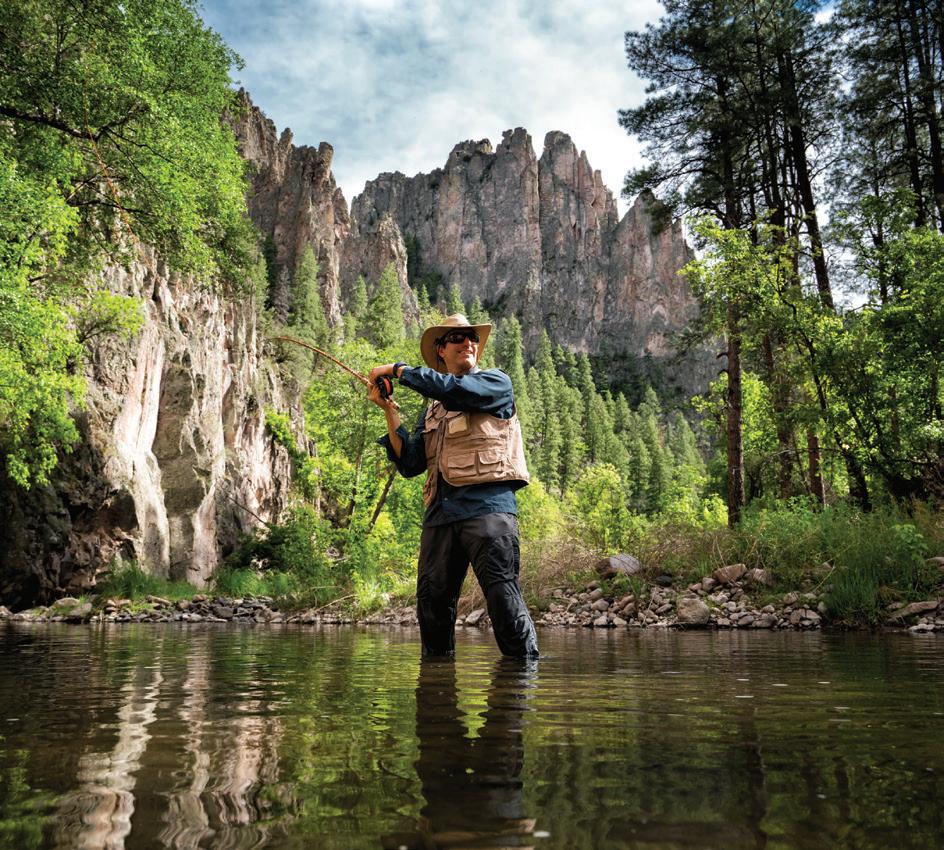







The Albuquerque Hispano Chamber of Commerce has been operating since 1975 promoting economic development, enhancing economic opportunities, and providing business and workforce education and training with an emphasis on Hispanic and small businesses in Albuquerque and New Mexico. We are recognized as one of the largest Hispanic Chambers in the Nation, while growing our partnerships with Mexico and Canada.
The Albuquerque Hispano Chamber of Commerce has been operating since 1975 promoting economic development, enhancing economic opportunities, and providing business and workforce education and training with an emphasis on Hispanic and small businesses in Albuquerque and New Mexico. We are recognized as one of the largest Hispanic Chambers in the Nation, while growing our partnerships with Mexico and Canada.
Join to engage with our membership base of over 1,200 businesses. Participate in monthly networking opportunities, free programming, education and workforce trainings, usage of our meeting rooms and facilities, full access to our business directory and much more. We provide a diverse range of programming to fit your needs, and unique ways to promote your business to the communities we serve. Obtain assistance from the SBDC, PTAC and MBDA, located on our campus, to grow and scale your business.
Join to engage with our membership base of over 1,200 businesses. Participate in monthly networking opportunities, free programming, education and workforce trainings, usage of our meeting rooms and facilities, full access to our business directory and much more. We provide a diverse range of programming to fit your needs, and unique ways to promote your business to the communities we serve. Obtain assistance from the SBDC, PTAC and MBDA, located on our campus, to grow and scale your business.
Connect with our various committees, including our International Trade Committee that is part of our Convention and Tourism Department promoting Albuquerque globally as a destination for conventions, conferences, and tourism with a specific focus on the Native American and Hispanic markets. With 5 active industry committees,
Connect with our various committees, including our International Trade Committee that is part of our Convention and Tourism Department promoting Albuquerque globally as a destination for conventions, conferences, and tourism with a specific focus on the Native American and Hispanic markets. With 5 active industry committees,





engage with a diverse group of business leaders from various industries to help grow your network. Attend the biggest gala in the Southwest, La Noche Encantada in February and then the most culturally significant business awards banquet during Hispanic Heritage month.
engage with a diverse group of business leaders from various industries to help grow your network. Attend the biggest gala in the Southwest, La Noche Encantada in February and then the most culturally significant business awards banquet during Hispanic Heritage month.
Thrive by participating in our programs such as our Procurement Summit, one of the best and largest in the state, offering a one-day seminar with subject experts on how to apply for and secure federal contracts. We also offer a separate 6-week procurement series and an 8-week Growing your Small Business Course, free to members. Learn how to maximize marketing and social media, while understanding how to handle legal, human resource, and financial issues that can affect any business from our top talent in the state.
Thrive by participating in our programs such as our Procurement Summit, one of the best and largest in the state, offering a one-day seminar with subject experts on how to apply for and secure federal contracts. We also offer a separate 6-week procurement series and an 8-week Growing your Small Business Course, free to members. Learn how to maximize marketing and social media, while understanding how to handle legal, human resource, and financial issues that can affect any business from our top talent in the state.
Join. Connect. Thrive. Contact the Hispano Chamber of Commerce TODAY to get started. www.ahcnm.org or (505)842-9003.
of
1309 4th Street SW Albuquerque, NM
505.842.9003
www.ahcnm.org
1309 4th Street SW Albuquerque, NM 87102 505.842.9003 www.ahcnm.org










